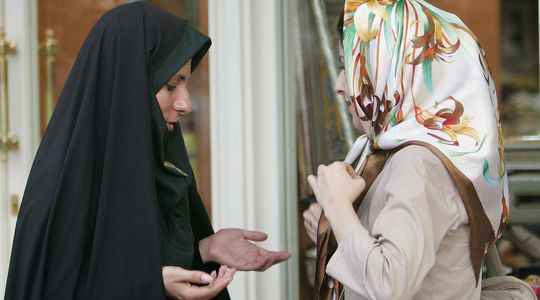Is the Tehran regime showing signs of weakness? The Iranian Attorney General announced on Saturday, December 3, the abolition of the morality police responsible for the arrest of the young Mahsa Amini, whose death provoked a wave of protests which has lasted for almost three months in Iran. This declaration, perceived as a gesture towards the demonstrators, came after the decision of the authorities to revise a 1983 law on the compulsory wearing of the veil, imposed four years after the Islamic revolution of 1979.
Mahnaz Shirali, sociologist and author of the book Window on Iran: The cry of a gagged people (Les Peregrines Editions), considers that this is a “great victory” for the protest movement, even if this announcement must be taken with a grain of salt, having not yet been confirmed by the government.
L’Express: What does the announcement of the abolition of the morality police announced by the Iranian public prosecutor mean?
Mahnaz Shirali: For women, this announcement does not mean much. We are in a country where a woman’s life is worth half that of a man. If a woman kills a man, she will be immediately executed. Whereas if a man kills a woman, all he has to do is pay a little money so he can get away with it. We are in a country where the testimony of women in the courts of morals is never accepted. If a woman files a rape complaint against a man, she can be whipped by the police. The abolition of the morality police means nothing in a misogynistic country whose laws have institutionalized violence against women. In the past, this font has been abolished many times, but it rises from its ashes each time.
But can we speak of a (small) victory for the protest movement?
At a time when society is on fire and bloodshed, this announcement of the abolition of the morality police is important, in my opinion. It shows that a regime armed to the teeth is retreating against young Iranians, whose only weapons are their anger and insults. This gesture can be interpreted as an admission of weakness on the part of the Iranian authorities. It’s a big victory, but young people don’t see it that way.
It was to be expected that the Iranian regime would back down. We are in the 21st century, no regime in the world can stay in place by massacring its nationals. The leaders of the Islamic Republic, completely cut off from society, do not understand what society demands. They think that by announcing the abolition of the morality police, the population will calm down. What they haven’t understood is that young people aren’t going to stop there. The young people outside want the abolition of the Islamic Republic and not that of the morality police. For the protesters, this announcement is a ruse on the part of the government to silence them.
Over the past three months, how has this protest movement evolved?
At the beginning, there was talk of a spontaneous and mass movement, but we did not know where it would go. Three months later, the movement is in the process of organizing and channeling itself. The organization is established on social networks (Twitter, Instagram). We also notice the presence of leaders of the movement, thinkers, theoreticians, who assert themselves more.
What form does the Iranian regime’s repression take?
His response is atrocity. He rapes young people in prisons, he tortures them, he drugs them and once he releases them, there are many inexplicable suicides. However, we examined young people who committed suicide and they all had one thing in common: they were drugged. In other words, their suicide was actually murder. Thus, parents are always asked to send their children for blood tests, as soon as they get out of prison, and to take them to the hospital to purify their blood, because they are heavily drugged. . On Saturday December 3, the regime announced 482 dead, including 62 children under the age of 10. The regime does not say it killed them.
In cities far from Tehran, the repression is getting stronger. The Islamic Republic believes that the gaze of the Western media is riveted on Tehran and the big cities. Western journalists do not see what is happening in border towns. For example, the Islamic Republic massacred the inhabitants of Zahedan, in the region of Balochistan, in the south-west of the country. She dares not commit such acts in big cities. It is at this time that we observe the strength of the Western media whose gaze saves lives. The role of Westerners is very important: they must take advantage of their influence to prevent the massacres, otherwise they risk having problems with their conscience.
Finally, what scenarios can we envisage concerning the continuation of the movement?
The regime can relax rules or carry out massacres. He is unpredictable and capable of anything. The Iranian authorities are very pragmatic. We never know who we are dealing with. They are unpredictable, hence their dangerousness. The Iranian people don’t want this regime, whether it’s lenient or nasty, they don’t care. Since the announcement of the abolition of the morality police, the demonstrators are even more determined to show the planet that their demand is the fall of the regime. They don’t want to negotiate with him. Iran is traversed by a movement that can be described as revolutionary.
